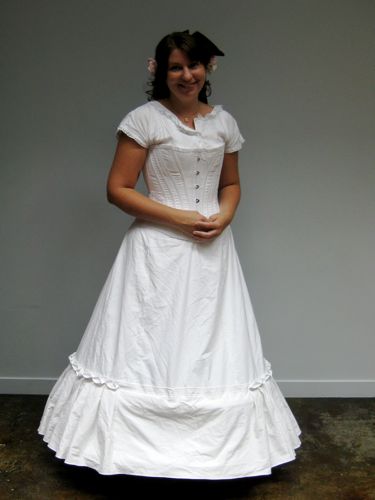I’ve realised that while I make lots of undergarments, some of them very pretty, I don’t often show models in just their undergarments, so I don’t get good photographs of the undergarments on real people.
Last Saturday solved a bit of that.
One undergarments I was especially pleased to get images of in action was the 1866 crinoline.
Mme Denise Poiret wore it, and looked fabulously 1860s and not at all Poiret-y.
The one inaccuracy with this wearing is that I put the corset over the crinoline for aesthetic impact. Audiences like to to see corsets in the full.
I fixed some of the issues that I was having with this crinoline for this wearing by slipping an extra set of very strong wire boning into the extra channels that I had providentially included in the crinoline when I originally made it.
The extra wires keep the crinoline from warping under the weight of the back ruffles, and help create a back-heavy shape, but also make the whole petticoat quite a bit heavier, which is a pity.
Despite the improvements, the crinoline still has some problems, and I’m wondering if they are fixable, or if they are inherent to the pattern, or if I cut the pattern wrong. The thing that irks me most is the pull lines from the back of the petticoat around to the front.
I’m also not sure about the ruffles down the back. I used circular cut ruffles because it seemed like a good idea at the time (e.g. I was overthinking this crinoline), but in retrospect, I don’t think they are at all historically accurate, and I don’t think they hang right.
At least I’m still in love with the bottom box-pleated ruffle.
I’m not going to re-make it though. It isn’t that often that I need a late 1860s crinoline, this one looks and works pretty well, and there are so many other things to make!








I should think a late 1860’s crinoline would see daily wear…
It’s pretty!
Yes, of course, it’s ever so practical for grocery shopping and my daily sewing!
heheh. I knew it. If I had one, I’d wear it around the house on days I woke up feeling like Scarlet O’Hara.
I must admit I didn’t have the time to make circular cut ruffles – just cut strips and passed them through the ruffler.
I think the heaviness is because of the fabric chosen – it should probably have been made from a lighter stiffer fabric (but I had difficulty sourcing fabric too)
I also found that mine did similar things when fitting on the mannequin, which has a smoother less defined waistline- but when I use it with my own corset – Mme Foy’s skirt supporting one – it sits so much better – because of the more defined waist. It is not about making a corset tightwaisted – more about it not being such a flattened line from bust down to hips – that shape of corset is better for the later era styles. I use a small bum roll to hold it out better on the mannequin.
Incidentally – Mme Foy’s is a great corset to wear – and does give a fab appearance of a waist – with less compression than those that continue the boning down to the hips…..
(I’d make a Mme Foy before I remake the
When you mentioned your irkedness over the way the creases show in the front I thought of a not at all period correct fix. It’s a bit the way bustles later in the period stayed on the bum- either some straps or a width of fabric sewn on the inside of the crinoline to keep the back away from the bum and keep it from swinging forward causing those nasty wrinkles. Hope this makes sense- I can see the solution in my head…
Clever you! I’ve actually been debating a very similar fix. And I wouldn’t call it ‘not all period correct’. I’d call it ‘undocumented, but not entirely lacking in plausibility’ ;-). After all, the bustles developed out of these hoopskirts.